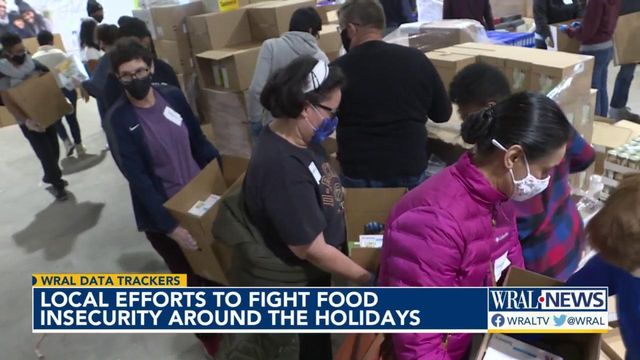More than 1.5 million North Carolina residents facing food insecurity, data shows
One of out every five children in the state lack continuous access to nutritious meal
Posted — Updated"Hunger is something that really shouldn't even exist in the United States of America," said Tamara Baker with the Carolina Hunger Initiative out of UNC. "We have plenty of food, but it's all about access."
WRAL stopped by the Food Bank of Central and Eastern North Carolina as they packed boxes and prepared to distribute them to people around the area.
"It is a real challenge for so many families out there and it's just been amplified during the pandemic," said Baker. "There are lots of ways to get help, but there are not these these automatic solutions that are just going to erase the problems. There are a lot of systemic issues that have been in place and continue to be in place. During the holiday, use your heart and have some compassion for these families and think about the challenges that they're that they are going through."
That food bank is in Wake County, which has one of the lowest rates of food insecurity along with Union and Cabarrus. Scotland, Robeson and Richmond counties have the highest.
"It's hard to find a place in North Carolina where there are not these economic challenges," Baker said.
She told us that rural communities, in particular, tend to face a lot issues with food security.
"The research shows us that the more rural you are, then the more likely there is to be more poverty."
About 20 percent of those who are food insecure are children. That means, more than 460,000 kids don’t know where their next meal is coming from.
"Study after study shows that food is a basic building block of a child's well being," Baker said. "That impacts their social-emotional learning; that impacts their ability to take that test that day. So, why do we as a society, not value food? And it's a question that has plagued us but has really been highlighted during COVID."
About 60 percent of the kids in North Carolina public schools qualify for free or reduced lunch, Baker said. So when COVID caused school closures, nearly a million children were affected. Schools and community organizations scrambled, partnering together to make sure students were still getting meals.
Again, it was more challenging in rural counties because of the lack of public transportation, food pick up hours and how the pandemic affected certain industries worse than others, Baker explained.
"They're having to make decisions between food and gas," said Baker. "It's a hard set of decisions to make."
Related Topics
• Credits
Copyright 2024 by Capitol Broadcasting Company. All rights reserved. This material may not be published, broadcast, rewritten or redistributed.





